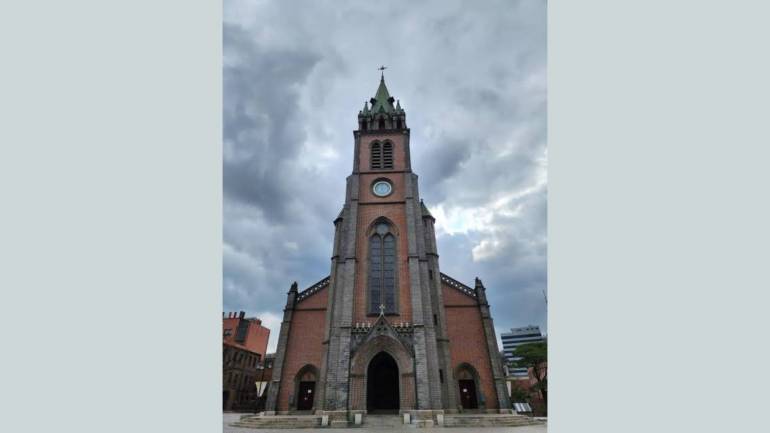Cathedral Church of Our Lady of Immaculate Conception: A Symbol of South Korea's Road to Democracy

Inside the church, the Nativity, the magi, Christ and his apostles, and the Rosary are depicted in large stained glass panels.
Historical Struggles and Triumphs of the Korean Catholic Church
Before this church was built in Korea, the French missionaries suffered severe persecution during the Great Joseon State, an absolute monarchy that reigned for half a millennium from 1392 to 1897.
Seven Catholic missionaries were executed in the 19th century. This prompted the French to send a punitive expedition to Korea in 1866 to exact justice for the death of the missionaries.
The battle broke out in Ganghwa, an island off Korea's west coast. But after more than a month of fighting, the French naval fleet retreated.
Toward the last remaining years of the Joseon period, Korea agreed to a commercial treaty with the United States in 1882.
After the treaty, the Apostolic Vicar of Korea purchased land. However, the locals protested that a Catholic church be constructed on the site as it was near a Confucian temple.
Gojong, the last king of the Joseon monarchy and the first emperor of the Korean Empire, also turned down the plan to build a Catholic church in the area. He nearly seized the land in 1887.
Gojong made a further step to discontinue the building of the cathedral by ordering his trade minister to discourage Italy, the United States, and Russia from funding its construction.
He even officially controlled the flow of the gold currency to slow down the construction.
One of the contentions of the emperor, according to historical records, to the plan of the construction of the cathedral was it would stand taller than his palace.
Despite all this, the construction of the cathedral pushed on.
Emperor Gojong eventually saw the importance of religious tolerance, and that allowing the church construction would bring peace, harmony, and good international relations. He laid the first stone of the church.
The cathedral stands on top of a hill. Made of red and gray bricks, it is the first church in Korea in the Gothic style.
After its completion in 1898, the cathedral became the tallest building in Seoul. It was originally referred to as Chonghyen, meaning bell hill in the Korean tongue.
The church measures 23 meters in height. Its bell tower stands 45 meters tall.
Inside the church, the Nativity, the magi, Christ and his apostles, and the Rosary are depicted in large stained glass panels.
An image of Our Lady of the Sacred Heart is rendered at the high altar. The cross enshrined in a ciborium is surrounded by the apostles.
Saint Benedict is featured in a side altar.
A side chapel is dedicated to Saint Andrew Kim Taegon and French Bishop Bum-Se-Hyeong.
Andrew Kim Taegkon was the first Korean priest. He was canonized along with 102 Korean martyrs by Pope John Paul II during his visit to Korea in 1984.
Bum-Se-Hyeong's French name was Laurent-Joseph-Marius Imbert. The Koreans dressed him in their traditional attire.
Underneath the main altar is the crypt, which stores the remains of nine Korean martyrs.
The church in Korea was formerly a part of the Diocese of Beijing, China.
After the Allied Forces, including the United States, Soviet Union (now Russia), and the United Kingdom, failed to agree on establishing a single government for the entire Korea in 1948, they divided it into two states: South Korea and North Korea.
Officially known as the Cathedral Church of Our Lady of the Assumption, this church has become a symbol of the Koreans' long road to democracy.
The Catholic priests were one of the outspoken critics of South Korea's military rule known as the Fifth Republic.
The authoritarian regime ruled South Korea from 1981 to 1987.
The Cathedral's Role in South Korea's Path to Democracy
The cathedral also played a role in the promotion of human rights in South Korea.
The cathedral became a center of pro-democracy protests during the military rule.
As a protest site, it was a witness to the June Democratic Struggle in 1987 that led to the collapse of the authoritarian rule, and the establishment of the Sixth Republic.
During the protests, nearly 4,000 people were arrested. But pro-democracy students were able to escape and sought refuge in the cathedral. The police set up a blockade to contain the students in the cathedral.
As a result, the students staged a sit-in inside the cathedral.
A sit-in is a form of protest by people occupying a particular area.
Hundreds of students attempted to join the pro-democracy protesters inside the church. But the police prevented them from entering.
Despite the authorities declaring the protest illegal, it gained public support.
The mass protests started on June 20, 1987. On June 29, the government announced to the public that it would yield to the demands of the protesters with the assurance of amending the Constitution and releasing the political prisoners.
The cathedral also played a role in the promotion of human rights in South Korea.
Currently, South Korea is regarded as one of the most advanced democracies in the region.








